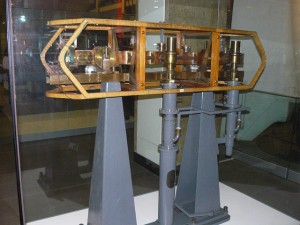Modern Times means Modern Time! Don’t trust the Earth, trust the Atom!
This was the first successful atomic clock. In 1955, when it was developed, it proved more accurate than any other time keeper in the world.
The use of stable vibrations of caesium atoms at a time standard was first proposed by the physicist Isidor Rabi. This led to a design built at the US National Bureau of Standards in 1951, but it was not accurate enough to replace existing master clocks.
In 1953, Louis Essen and JVL Parry, at the National Physics Laboratory, began work on a parallel approach. The challenge was to provide a microwave radio signal that would be ‘locked’ to natural radio frequency that excites caesium atoms to switch between energy states. This principal has been likened to the atomic pendulum.
By 1955, they had developed a clock to provide an accuracy of one second in 300 years. This work led to the current international system whereby time is set by averaging results from atomic clocks in many laboratories across the world.
Text from the display at the Science Museum
The development of the Caesium I atomic clock illustrates many themes and issues within this module, specifically the discussions on Big Science and atomic research as well as the post-war perceptions of science.
Historians suggest that there was intense competition between the two western super powers in relation to Big Science during the mid-twentieth century, specifically Big Science being seen as something mainly happening in America with Britain struggling to keep up. Yet, the political difficulties in the USA which almost ended their research into atomic clocks consequently resulted in Britain’s Caesium I becoming the world’s first source of atomic time. This shows two things; that the supposed ‘brain drain’ of Britain which saw British scientist’s move across the pond due to lack of government support must be questioned, and in turn that America perhaps weren’t as productive in terms of Big Science as is commonly thought. Thus, in being the first successful atomic clock created Essen’s Caesium I questions the extent to which America was leading in Big Science. Moreover, the fact that in the early 1950’s Essen became interested in the research being conducted in America, and then took that research one step further, significantly shows that there was communication between Britain and America in terms of Big Science.
The Caesium I further demonstrates the nature of mid-twentieth century modernity as well as the altering perceptions of science. In 1953 Essen and Parry were given Government approval and funding to produce an atomic clock at the National Physics Laboratory, revealing that there was a demand for more accurate time keeping. It was costly research, and the investment shows that Britain realised it needed to keep up with the times. As the Science Museum online declares, ‘it is difficult to imagine that we need to measure time so accurately but it is essential for many aspects of modern life which we take for granted […] many industrial and commercial activities need this level of accuracy.’ This work led to the current international system whereby time is set by averaging results from atomic clocks in many laboratories across the world. More accuracy in time keeping illustrates how every part of modern life was accelerating, not only in science and technology. The original definition of the second as 1/86400 of a mean solar day was abandoned because the Earth’s motion was not reliable enough. The Earth was thus deemed outdated and could not keep up with the acceleration of modern life. The atomic clock would now form the new basis of modern life, not our own planet.
Most importantly, Essen’s Caesium I illustrates the brighter side of atomic research. Generally, the term ‘atomic’ was – as is now – associated with the bomb in the public mind. The fact ground breaking developments in time keeping were undertaken using atomic research suggests a conscious attempt to make ‘atomic’ not always induce negativity and moral antipathy. In turn, this could further seen as an aim to alter the negative perception of science and scientists generally, following the atomic bombings of Hiroshima and Nagasaki. Perhaps this was not successful at the time in altering the British attitude towards atomic science, but why should it not be so now? Indeed, at the very least, the Caesium Atomic Clock should remind us that in mid-twentieth century Britain the word ‘atomic’ didn’t always follow with the word ‘bomb’.
by Emily Jane Roe


Recent Comments